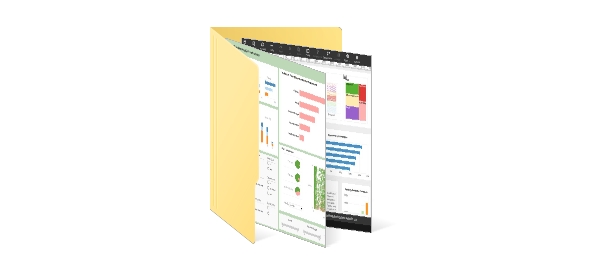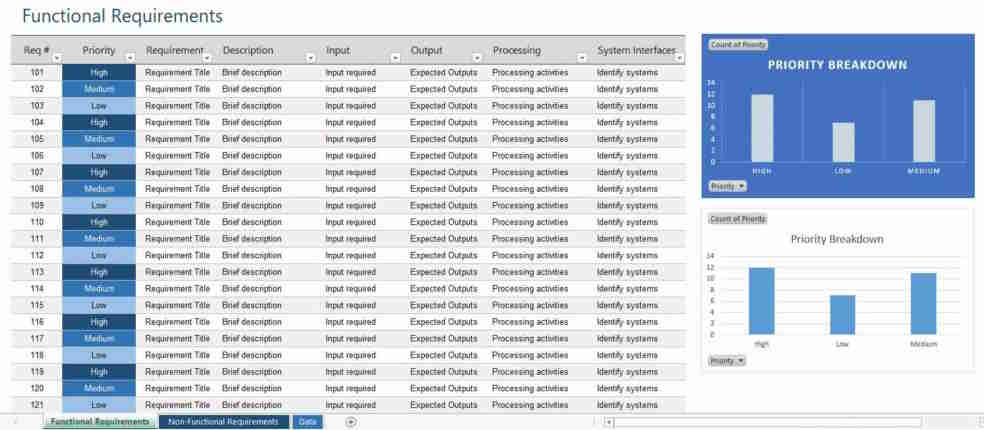What KPIs and Analytics Are Used on Requirements Management Dashboards?
Good requirements management is essential to making sure a project or product is delivered successfully. Managing requirements entails acquiring, documenting, and verifying requirements, monitoring changes, and ensuring they meet project goals.
This is where requirements management dashboards may assist teams obtain insights, make educated choices, and enhance software or project quality. This article discusses requirements management dashboard KPIs and analytics and their role in the software development lifecycle.
| #1 Ranking: Read how InetSoft was rated #1 for user adoption in G2's user survey-based index | Read More |
Requirement Traceability
A good requirements management method is predicated on effective requirement traceability. It is keeping track of and recording the connections between different needs in order to make sure that every demand can be linked to its original source—a business need or stakeholder request, for example.
Key KPIs and Analytics:
- Traceability Matrix Completion Rate: The proportion of needs that have been successfully tracked down to their original sources is measured by this KPI. A greater percentage of completion signifies a stronger traceability, lowering the possibility of criteria being overlooked.
- Cross-Requirement Impact Analysis: analytics that highlight the effects and interdependencies among requirements. Comprehending these associations facilitates the evaluation of possible impacts of modifications on other prerequisites, hence enhancing change management.
Requirement Coverage
The degree to which the stated requirements cover the whole scope of the project or product is known as requirement coverage. Making ensuring that no important details are missed throughout development is crucial.
Key KPIs and Analytics:
- Requirement Coverage Percentage: This KPI calculates the percentage of requirements that the project has successfully handled. When the coverage % is high, it means that the project is in line with the original specifications.
- Coverage Gap Analysis: Analytics that bring out gaps in requirements, assisting teams in identifying possible hazards and setting priorities for further work.
Requirement Change Management
Any project will always experience changes, and requirements management dashboards are essential for managing these changes. Documenting, assessing, and putting into practice required modifications are all part of effective change management.
Key KPIs and Analytics:
- Change Request Turnaround Time: This KPI measures the speed at which change requests are handled, providing insight into the effectiveness of the change management procedure.
- Change Request Approval Rate: analytics that evaluate the proportion of authorized modification requests. A high approval rate may indicate that stakeholders and the project team are working together and communicating well.
Requirement Quality
Requirements for high quality are explicit, conflict-free, and transparent. Making sure the specifications are of a high enough caliber is essential to preventing miscommunications and rework throughout the development phase.
Key KPIs and Analytics:
- Requirement Review Findings: The quantity of problems or discoveries found during requirement reviews is tracked by this KPI. A tendency toward fewer finds over time points to an improvement in the quality of the requirements.
- Requirement Clarity Score: analytics that evaluate the requirements' clarity according to predetermined standards. This score aids in determining which needs deserve improvement.
 |
Learn about the top 10 features of embedded business intelligence. |
Requirement Status
A quick overview of each requirement's place in the development process is given by the requirements status. This covers the status of requirements—whether they are finished, in process, or pending.
Key KPIs and Analytics:
- Requirement Completion Rate: The proportion of requirements that have been effectively executed and validated is measured by this KPI. A high completion rate is a sign of development and helps in creating project timetables that are reasonable.
- Requirement Aging Analysis: analytics that evaluate how long a requirement has been in a certain state. It assists in identifying needs that may be stalled or facing delays.
Requirement Priority
There are often varying degrees of relevance for requirements. Setting criteria in order of importance guarantees that the most important aspects are taken care of first, improving project results.
Key KPIs and Analytics:
- Priority-Based Requirement Implementation: When executing requirements, adherence to the priority order is measured by this KPI. It aids in making sure that needs with a higher priority don't take precedence over those with a lower priority.
- Priority Changes Analysis: analytics that monitor changes in the order of requirements throughout time. It aids in comprehending how stakeholders' requirements are changing and how it will affect the project.
 |
Learn the advantages of InetSoft's small footprint BI platform. |
Requirement Baseline and Versioning
An image of the needs at a certain moment in time is called a requirement baseline. The process of keeping several versions of requirements to monitor updates and past events is known as versioning.
Key KPIs and Analytics:
- Baseline Compliance: The degree to which the project follows the original requirement baseline is gauged by this KPI. It aids in managing changes in scope.
- Version Control Analytics: analytical tools that show how requirements have changed throughout time. This is essential to understanding the evolution of decisions and changes across time.
Requirement Validation and Verification
While verification verifies that the criteria are accurately implemented in the product, validation makes sure the requirements match the intended business need.
Key KPIs and Analytics:
- Validation and Verification Time of Cycle: The time required to complete validation and verification tasks is measured by this KPI. Reduced cycle times may be a sign of effective requirement accuracy assurance.
- Requirement Defect Density: analytics that monitor how many requirements flaws are discovered during verification. Higher required quality is shown by a lower defect density.
 |
View the gallery of examples of dashboards and visualizations. |
Stakeholder Collaboration
Collaborating effectively with stakeholders is essential to obtaining and fine-tuning needs. Dashboards may provide information about the team's level of stakeholder relations.
Key KPIs and Analytics:
- Stakeholder Feedback Incorporation Rate: The effectiveness and speed with which stakeholder input is incorporated into the requirements is gauged by this KPI. A high rate indicates a flexible and accommodating staff.
- Stakeholder Engagement Analytics: analytics that evaluate the volume and quality of interactions with stakeholders. Better requirements alignment with business needs is often the consequence of increased involvement.
Requirement Metrics Trends
Making educated judgments and seeing patterns or trends in requirements management need the analysis of past data.
Key KPIs and Analytics:
- Historical Trend Analysis: In order to find patterns, abnormalities, or reoccurring problems, this entails monitoring KPIs and analytics over time. Making proactive decisions is aided by it.
- Predictive Analytics: Making forecasts about future needs and project results based on previous data. This may help with risk reduction and resource allocation.
 |
Read the top 10 reasons for selecting InetSoft as your BI partner. |
Regulatory Compliance and Audit Trail
Adherence to rules and regulations is required in some businesses. Dashboards may support the upkeep of an audit trail for compliance documentation.
Key KPIs and Analytics:
- Compliance Check Pass Rate: The rate at which the project passes compliance inspections is evaluated by this KPI. High pass rates that are constant show that the rules are followed.
- Audit Trail Analysis: Analytics that enhance compliance verification by providing a thorough record of requirement modifications and approvals.
Requirement Stakeholder Satisfaction
An essential component of success is the contentment of all parties involved, especially end users. Dashboards for requirement management may provide information on this.
Key KPIs and Analytics:
- Stakeholder Satisfaction Surveys: surveying stakeholders to get their input and evaluating their degree of satisfaction with the outcomes as a KPI.
User Acceptance Testing (UAT) Success Rate: Analytics that gauge how well requirements match user expectations by tracking the success rate of user acceptance testing.
 |
Learn how InetSoft's native big data application is specifically designed for a big data operating system. |
Resource Allocation and Workload Balance
Meeting project deadlines and preserving team morale depend on effectively allocating resources and distributing duties among team members.
Key KPIs and Analytics:
- Resource Utilization Rate: The efficiency with which resources are used is gauged by this KPI. It may draw attention to excessive or insufficient use of team members.
- Workload Balance Analysis: analytics that show how team members divide up the job. Workload balance promotes equal contributions and helps to avoid fatigue.
Risk Management
Identification and mitigation of risks that may affect a project's successful completion are also part of requirements management.
Key KPIs and Analytics:
- Risk Identification Rate: This KPI assesses the team's ability to recognize possible requirements-related hazards. Proactive risk management is indicated by a greater rate.
- Risk Mitigation Success Rate: analytics that monitor how well risk reduction techniques are working. It facilitates evaluating the group's capacity to handle and minimize risks.
 |
Learn how InetSoft's data intelligence technology is central to delivering efficient business intelligence. |
Requirements Documentation Compliance
Strict adherence to documentation standards is necessary for requirements that are explicit and clear. Dashboards are useful for ensuring adherence.
Key KPIs and Analytics:
- Documentation Standard Adherence Rate: This KPI assesses how closely requirements documentation adheres to accepted norms. Better documentation quality is indicated by higher adherence rates.
- Documentation Review Findings: analytics that monitor problems or discrepancies in the requirements list. Fewer results point to increased quality and compliance.
Agile and DevOps Integration
Agile and DevOps approaches are widely used in enterprises for software development. Integrating these strategies is essential.
Key KPIs and Analytics:
- Sprint and Release Burndown Charts: KPIs that demonstrate how much work has been completed throughout sprints and releases are crucial for Agile teams.
Analytics that evaluate the effectiveness of continuous integration/continuous deployment (CI/CD) pipelines, demonstrating the seamless integration of development and deployment procedures, are referred to as pipeline success metrics.
Read what InetSoft customers and partners have said about their selection of Style Scope for their solution for dashboard reporting. |
Cost Management
A key component of requirements management is controlling project expenses and guaranteeing that needs are fulfilled within the allocated budget.
Key KPIs and Analytics:
- Requirement Cost Variance: This KPI calculates the difference between the actual and expected implementation expenses. Effective cost management is shown by smaller variations.
- Cost-Benefit Analysis: Analytics that assist prioritize high-value features by evaluating how cost-effective it would be to achieve certain needs.
Team Productivity and Efficiency
Enhancing the development process requires measuring the output and effectiveness of the team.
Key KPIs and Analytics:
- Velocity and Throughput: KPIs that quantify the quantity of work completed in a certain length of time are essential for Agile teams.
- Cycle Time Analysis: analytics that evaluate how long it takes to finish each requirement, pinpointing bottlenecks and areas for development.
 |
View the gallery of examples of dashboards and visualizations. |
Requirement Accessibility and Version Control
Collaboration depends on making sure that everyone in the team has access to the most recent requirements and is able to follow changes.
Key KPIs and Analytics:
- Requirement Access Rate: The effectiveness with which team members can obtain requirements is gauged by this KPI. High access rates are a sign of effective teamwork and communication.
- Version Control Effectiveness: Analytics that monitor the system's performance in managing the versions of requirements, lowering the possibility of utilizing out-of-date data.
Project Alignment with Business Objectives
In the end, a project or product's success is determined by how well it fits in with the larger corporate goals and plans.
Key KPIs and Analytics:
- Business Objective Alignment Score: The degree to which the project or product is in line with the organization's strategic objectives is evaluated by this KPI.
- Requirement Benefit Realization: Analytics that verify alignment with company goals by quantifying the real advantages obtained from putting certain criteria into practice.


